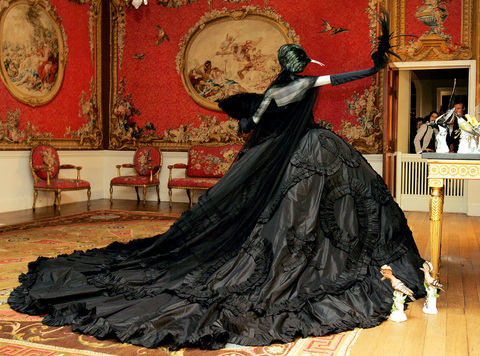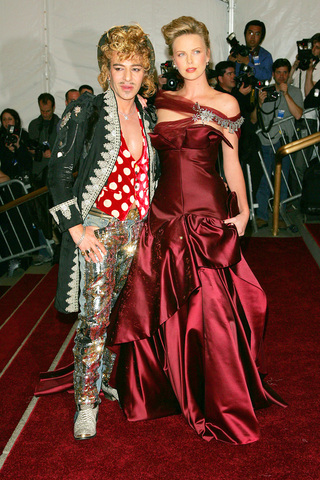If John Galliano, the designer at Dior, were not so recognizably talented, he might be considered a joke.
For every show he changes his look, and his guises are as varied as Cindy Sherman's. On the day of the recent Costume Institute gala at the Met, he slipped into a booth at the Four Seasons wearing a well cut, if severe, brown pinstripe suit and a snap-brim cap. Four hours later, materially transformed by sequins and golden curls, Juan Carlos Antonio Galliano looked like Davy Crockett in drag. The bloggers went to town.
But there is the fact of his talent, which rises up to greet you like a brick wall. It is unavoidably great. In two decades, he has staged at least half a dozen shows that people still vividly remember.

PHOTO: AP
These include the 1993 Princess Lucretia show in which he used electrical wire to give his skirts swing; a 1994 show in an empty Paris mansion in which all the dresses were made from black satin-backed crepe (it was a fabric he could afford and it could be used on both sides); the 1999 Matrix show, at Versailles, in which he offended Dior's old clients and established the house's modernity; and the 2000 hobo show that put fashion on the front page.
He is one of the few designers working today who actually knows how to cut cloth. If your daughter is wearing a bias-cut prom dress this spring, it is largely because years ago Galliano pushed manufacturers to try the technique on an industrial scale. His clothes have been judged unwearable and, more recently, overly commercial and safe. But as with all far-sighted talent, the judgments are eventually reversed. What once looked unwearable now seems ordinary, and what once seemed banal now looks right.
On May 15, Galliano was in New York to present Dior's resort collection. Though resort clothes don't get (or deserve) the news media attention of couture and ready-to-wear, Dior decided to make an event of it, inviting fashionistas as well as movie people, like Spike Lee and the producer Harvey Weinstein, and feeding them baked potatoes with caviar and Champagne at a dinner afterward. Bernard Arnault, the chairman of LVMH Moet Hennessy Louis Vuitton, which owns Dior, flew from Paris with his wife, Hilhne, as did the editors of French Vogue and Le Figaro.

PHOTO: AFP
To the Hollywood guests, the scene at the show must have had an ancient regime quality despite the modern setting of the LVMH Tower on East 57 Street. "I don't know how you do it," a Hollywood guest said with a grin to a journalist. "You're always looking at the same people at these shows. They never change!"
Well, in a way this is also Galliano's problem. How does a maverick at age 46 perform magic when those judging him remember the old tricks, and even occasionally complain he was better then? And how does Galliano satisfy his own creativity when he has to feed a global business, its annual sales approaching US$1 billion, with more than 200 stores and new customers who suddenly and perceptibly don't care about what a glamorous windbag in New York thinks about his genius cutting?
Like the Artful Dodger, whose sense of freedom he transmits in both his own style and his runway collections, Galliano has an instinct for survival. A couple of years ago, when he started showing more conventional-looking clothes, along with handbags, many people took this as a sign that, at least in his ready-to-wear shows, he had finally been reined in by Dior executives.
But over lunch recently, Galliano said: "That was me. I decided to do that. Very odd to see a girl walking down the runway with a bag, I agree. But, at the same time, I knew that a certain girl with a certain shaped bag would get the image out there." And of course, increasingly the image is the message.
"It's also a question of time as well," he said. "Gone are the days of the great Balenciaga and M. Dior, when you had six months to create a line, a silhouette. That's what I try to do in haute couture. But the timing is very different today."
Does he feel he has time to be creative? "It's programmed," he said. "I mean, you can't come into the studio one day and say, `I'm really feeling this design."' He laughed. "It's more programmed than that. No, it doesn't bother me. I need it."
At almost every turn in his 10 years at Dior, beginning with the Matrix show, which included clothes that had been taken apart and put together backward or upside down, Galliano has demonstrated a greater ability to change than his audience. I know: in a review of the Matrix show, I wrote, "Even if there was something believably modern here, the sort of world Galliano was envisioning hardly needs haute couture."
I took the clients' side. Wrong move. In haute couture, at least as it's practiced by Galliano and Karl Lagerfeld, you trust the designer. The modernity of Galliano's torn-apart approach was eventually borne out in the imitations.
In the late 1980s, in a small Italian magazine called Westuff, Galliano said he considered himself part of the establishment. Given his circumstances at the time -- near poverty, no regular source of financing and serious amounts of clubbing -- this may have been a case of telling a journalist what he wanted to hear. Yet despite his working-class upbringing and the outlaw poses, Galliano's understanding of fashion and business does lie with the establishment.
Reminded of the article, he said: "I was a baby. How bold of me to say I want to be an international designer and have a house in Paris! But there you go. There's no point fighting it. Embrace it. Work within it, and then do things."
He acknowledged the front-row complaints that Dior has gone too commercial without addressing them. "Um, can it ever be too commercial?" he said. "I think what we're doing is right for the time. I don't want Dior to rest as a niche brand."

“Why does Taiwan identity decline?”a group of researchers lead by University of Nevada political scientist Austin Wang (王宏恩) asked in a recent paper. After all, it is not difficult to explain the rise in Taiwanese identity after the early 1990s. But no model predicted its decline during the 2016-2018 period, they say. After testing various alternative explanations, Wang et al argue that the fall-off in Taiwanese identity during that period is related to voter hedging based on the performance of the Democratic Progressive Party (DPP). Since the DPP is perceived as the guardian of Taiwan identity, when it performs well,

The Taiwan People’s Party (TPP) on May 18 held a rally in Taichung to mark the anniversary of President William Lai’s (賴清德) inauguration on May 20. The title of the rally could be loosely translated to “May 18 recall fraudulent goods” (518退貨ㄌㄨㄚˋ!). Unlike in English, where the terms are the same, “recall” (退貨) in this context refers to product recalls due to damaged, defective or fraudulent merchandise, not the political recalls (罷免) currently dominating the headlines. I attended the rally to determine if the impression was correct that the TPP under party Chairman Huang Kuo-Chang (黃國昌) had little of a

At Computex 2025, Nvidia CEO Jensen Huang (黃仁勳) urged the government to subsidize AI. “All schools in Taiwan must integrate AI into their curricula,” he declared. A few months earlier, he said, “If I were a student today, I’d immediately start using tools like ChatGPT, Gemini Pro and Grok to learn, write and accelerate my thinking.” Huang sees the AI-bullet train leaving the station. And as one of its drivers, he’s worried about youth not getting on board — bad for their careers, and bad for his workforce. As a semiconductor supply-chain powerhouse and AI hub wannabe, Taiwan is seeing

Jade Mountain (玉山) — Taiwan’s highest peak — is the ultimate goal for those attempting a through-hike of the Mountains to Sea National Greenway (山海圳國家綠道), and that’s precisely where we’re headed in this final installment of a quartet of articles covering the Greenway. Picking up the trail at the Tsou tribal villages of Dabang and Tefuye, it’s worth stocking up on provisions before setting off, since — aside from the scant offerings available on the mountain’s Dongpu Lodge (東埔山莊) and Paiyun Lodge’s (排雲山莊) meal service — there’s nowhere to get food from here on out. TEFUYE HISTORIC TRAIL The journey recommences with